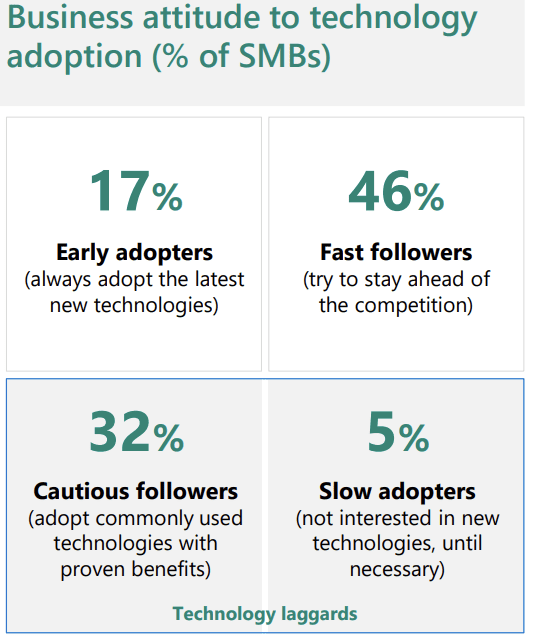Many small and medium businesses (SMBs) look to digital technology to grow, cut costs, improve efficiency, and access new markets. However, needs and behaviour of SMBs are different from those of larger organizations. SMBs are more likely to be influenced by individual executives when it comes to making decisions. In the past, SMBs would buy technology from solution providers. However, the Covid-19 pandemic, the trend of working from home and need for resilience has accelerated digital transformation.
Many SMBs are now looking for more than just technology solutions. They want help and advice when it comes to their technology strategies. Microsoft, in partnership with Analysys Mason, did a study to better understand the needs of SMBs to know how technology adoption by them affects their business results. Here is the summary of the study.
SMBs want technology to directly support business growth, maximize profits and achieve operational excellence.
In India, 39% of surveyed SMBs look to technology to help them to grow their customer base while 38% want to improve customer retention. 38% of SMBs in South Africa would like technology to help them increase their sales. SMBs in the USA believe that technology will help them with product innovation (33%).
More millennial executives see technology as important to their business than older peers. 68% of millennials say that technology is very important or essential, while only 55% of older peers say the same. Executives who are technophiles are nine times more likely than skeptical executives to lead SMBs to use technology early.
47% of SMBs in the USA are choosing technology to improve security while it is ease of use that SMBs in South Africa give importance (46%).
When SMBs are choosing technology, they do not always consider the cost and value for money. Fewer than a third of them select cost and value for money at the evaluation stage, suggesting that they care about other factors more than the absolute cost when picking technology options.
SMBs do not use one source of information to research technology applications. Instead, they use a variety of sources, including the documentation and reviews from technology providers’ websites and social media.
50% of SMBs expect their technology partners to suggest new technologies to them. Technology partners are becoming more important, and SMBs want those partners to be proactive in bringing them solutions.
31% of SMBs prefer buying technology products and services from MSPs and CSPs. Many SMBs cannot afford to have an IT specialist on staff, so MSPs and CSPs can be very helpful in providing support for SMB technology challenges. MSPs and CSPs can supplement the skills of an SMBs internal IT team by providing specialist skills that the SMB may not have access to. The next most common preference among SMBs is to partner with ISVs. Some SMBs believe they can access more customized solutions by working with ISVs, instead of the mass-market products of MSPs/CSPs.
25% SMBs in India prefer working with application developers/ISVs. In Australia, early adopters (42%) most commonly use application developers and ISVs while only 23% partner with MSPs/CSPs.
Almost all SMBs now have CSR/ESG objectives, but the way they assess and report on them can show how engaged they are in these objectives. Early adopters have similar CSR/ESG objectives to technology laggards. 38% of early adopters prioritize diversity and inclusion whereas only 26% of technology laggards prioritize this objective.
72% of early adopters in Australia have an annual CSR/ESG-specific assessment. 10% of early adopters in Mexico do not have CSR/ESG reporting.
Across different SMB segments, millennials are more commonly found in technology decision-making roles in middle-income markets. Despite this, millennial executives are specifically 1.5 times more common among early adopter SMBs than laggards in middle-income markets, like China, India, Mexico and South Africa.
Early adopters in China are most commonly led by millennials. 76% of early adopters have millennial leaders whereas it is 34% for laggards. Similarly, 57% of early adopters are led by millennial executives in South Africa compared to 34% of technology laggards.
The findings from the study show that many SMBs expect more than just technology solutions; they want help with digital transformation. How can SMBs effectively implement digital technology in order to improve resilience and keep up with larger organizations? Let us know in the comments below!
Source: Microsoft
Read next: Gartner outlines seven disruptions CIOs must be aware of!
Your email address will not be published. Required fields are marked *
You may use these HTML tags and attributes: <a href="" title=""> <abbr title=""> <acronym title=""> <b> <blockquote cite=""> <cite> <code> <del datetime=""> <em> <i> <q cite=""> <s> <strike> <strong>
Barriers
